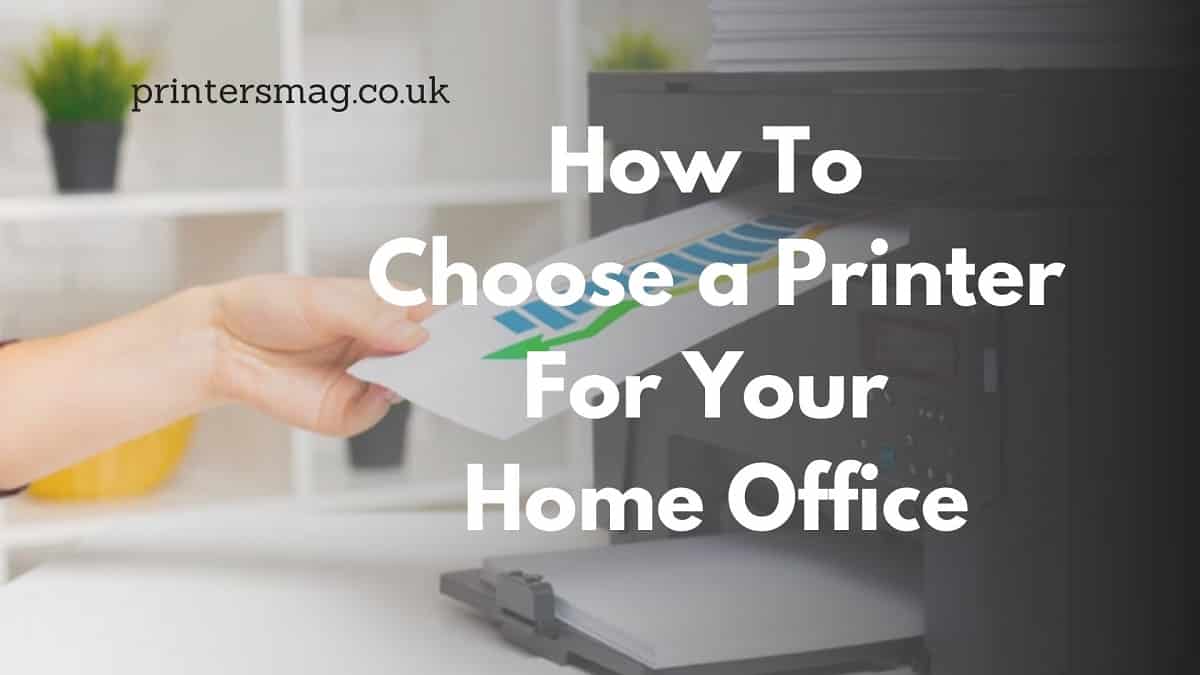
How To Choose a Printer For Your Home Office
The need for home office printers has increased as many of us are learning at work or from home. As a parent, if you want to print a workbook for your child or you get bored of trekking to your local office supply store to print occasional forms every day, then there is a home printer that can print everything you need.
If you need a printer yourself, it’s not hard to find the best one. In the last few years, printers have not changed, but they have just become more efficient and less expensive. You can still choose between laser and inkjet printers, color and black-ink printers, and only print and multifunction printers. But it is a good idea to find out what you want before you make all the decisions.

In this article, I will explain to you how to choose the best home office printer, what to look for in a printer you are choosing, what you should get, and how to buy without telling you which specific printer to purchase. I have also put together some buying guides for selecting a home office printer which will help you to choose the best one for you.
So, Let’s Start…
Table of Contents
Inkjet Vs Laser Printer
If you don’t need a printer before or you are buying a printer for the first time, you need to know the difference between an inkjet and a laser printer.
Inkjet Printers:
Inkjet printers are cheap and provide richer colours. If you mostly want to print photos, an inkjet printer is a decent choice for you. Inkjet printers are one of the most common types of printers used in commercial and home settings. These all-in-one printers are more convenient for home use since you can also use them for scanning or photocopy.
Inkjet printers spray small drops of liquid ink on one page. There are many types of inkjet delivery systems, but most consumer systems use separate ink cartridges. Each cartridge is fitted with a printhead that separates the ink into microscopic drops. Colours are created by combining different coloured inks.
There are some inkjet printers in the market which are known as supertank printers. It has refillable tanks that offer a lower price per page than traditional ink cartridges. They have been sold by some manufacturers such as the Brother, Canon, and Epson, and can be considered if you plan to do more colour printing.
Inkjet printing technology was developed in 1950 and still today, it is more popular due to its lots of advantages and minimal drawbacks. Let’s see.
Advantages:
- Capable of producing photo-realistic prints
- Practically no warm-up time
- Small footprint
Disadvantages:
- High running costs (Cost per page)
- Wet prints
- Slow print speeds
- Prone to clogging
- Sometimes produce erroneous empty cartridge warnings
Laser Printers:
For high-volume document printing, a monochrome laser printer is best for you. All-in-one laser printers offer maximum usages and keep running costs low. These printers are perfect for both small and large offices.
Typically, entry-level monochrome laser printers are more expensive than basic laser printers and consume more power. However, they are large and heavier but faster than inkjet printers.
These printers use lasers to generate static electricity on the rolling drum inside the printer. This static electricity attracts toner which is melted on paper. Basically, the ink in this printer is in the form of powder.
Initially, toner cartridges cost more than ink cartridges, and they also last longer than liquid ink. As a result, your cost per page will be lower. Laser printers also cost more than inkjet printers in the early days but they can save money in the long run.
When the idea of using a laser to draw images on a copier drum was considered, the laser printer was developed by Xerox in 1960. Still these printers are widely used in large offices because they are traditionally more efficient than inkjet printers. There are several advantages of laser printers over inkjet printers. Let’s see.
Advantages:
More cost-effective than inkjet printers
Increases productivity
High print speed
Higher paper capacity
Often expandable with Paper Trays, finishers, etc.
Disadvantages:
May require short warm-up times
Larger footprint
High voltage usage leads to small carbon emissions
Printer For Home Office
While each home office is separate, some generalizations apply to this office setting. Most home offices are limited in size and a lot of space is not available for storing different devices. For this reason, an inkjet all-in-one printer is a popular choice for anyone with a home office. Because they are amazingly versatile. They allow colour printing, black-and-white text printing, copying, and scanning from a compact device. And most importantly, inkjet printers are less expensive than laser printers.
However, a laser printer can be a great choice if you regularly print large amounts of black-and-white text and don’t need to print either graphic or color. If you choose a laser printer, it’s still worth investing in all-in-one functionality that allows you to scan and copy documents.
Another idea for a home office printer is to invest in a wireless printer if you are using a laptop, tablet, or other mobile devices for work. It allows you to print anywhere, from any of your devices, which can enhance your performance.
Multifunction Printers:
Multifunction printers are sometimes known as an all-in-one printer which ensures to perform printing, copying, scanning and faxing tasks. These printers can complete multiple tasks within an office or domestic environment. If you need to work from home in the future, you can consider a multifunction printer.
These printers are very easy to keep paperwork around your home to a minimum, as you can save a PDF of most of your documents and then dispose of the actual hardcopy. Most customer-level multifunction printers allow you to copy anything on 8.5 x 11-inch paper, but you can also buy printers that allow you to handle 8.5 x 14-inch paper. Suppose you see yourself copying or scanning a lot, in that case, you should find a multifunction printer with an automatic document feeder, which allows you to quickly move many pages through the system.
Advantages:
More compact
More cost-efficient as well as power-efficient
Perform numerous tasks simultaneously
Disadvantages:
Restrict usage time available for larger workgroups
Input And Output Trays
Now-a-days most printers work by pulling the paper from the front and running it around a drum or roller and then popping it out in the output tray. However, if you are printing on heavy stock and you do not want to bend the paper, in such a case, you can find a printer in which the input tray coming from the back of the printer, so that the paper will be pushed through on a straight line.
Some printers allow you to place more than one paper tray in front. For example, letting you choose a different color of paper, or having one tray hold letter-sized paper and another hold legal-sized.
It is also important for you to know how many documents your input and output trays are capable of holding. If you plan to print a 200-page manuscript, you may definitely not want an output tray capable of handling only 50 pages, or you could find 150 pages strewn over your floor.
Duplexing
The ability to duplex is to print on both sides of the single page. Actually, it is common, but not all low-priced printers include this feature. Duplexing is very important and useful, especially if you doing a lot of printing and want to save on the paper cost. Of course, most of the printers allow you to print on both sides of the paper by manually re-feeding the paper into the printer after the first side has been printed.
Wireless Connectivity
When you buy a printer, always remember and make sure it is capable of wireless connectivity via Bluetooth, NFC, Or Wi-Fi. Also, check whether it is compatible with the computer or mobile device you plan to use. If you have a Mac computer, an iPad, or an iPhone, make sure your printer is compatible with Apple AirPrint.
If you are using a Chromebook, by checking the manufacturer site make sure your printer is Chrome OS compatible. For example, Epson has a page that lists all Chrome OS-compatible printers.
Photo Printers:
If photography or graphic design is your passion, the portable snapshot printer will be best for you. Whether you are an advanced hobbyist or a professional and want a high-end or near-dedicated printer capable of printing text, a photo printer is a great choice. These inkjets can contain up to 12 ink tanks for more accurate colour reproduction. Most large format prints offering professional-quality prints up to 13 x 19 inches and some in banner size as well.
There are also some small and portable printers such as HP Sprocket Portable Photo Printer that allows you to print small pictures instantly. These printers are actually fun and useful for family gatherings and parties. If you are a professional photographer, then you may invest in a high-level photo printer. But otherwise, most midlevel color printers will work well enough if you use good photo paper.
Printer Running Costs
Check the total cost of ownership. Most manufacturers will tell you the price per page and many will offer cost per photo. To get the total cost of ownership, calculate the cost per year for each type of output by multiplying the cost per page for that type of output by the number of pages you print per year. Add up to three amounts together to get the total cost per year. Then multiply the number of years the printer is expected to own and add the initial cost of the printer. Compare the total cost of ownership statistics between printers to find out which model will be the cheapest in the long run.
Where Should you Buy it?
Printers are available at almost any online or in-store location that sells laptops and other computer equipment, such as Amazon, Best Buy, or B&H. You can also usually buy a printer directly from the manufacturer. For example, HP, Canon, and Epson all sell from their websites.